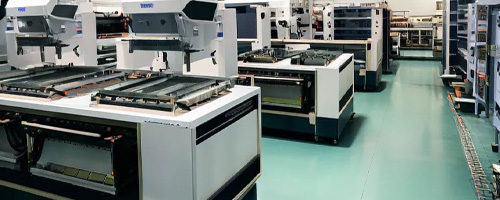 RU
RU
 EN
EN
 CN
CN

Position:HOME > SOLUTION > Screen Print

Screen printing consists of five main elements: screen printing plate, scraper, ink, printing table, and substrate. The screen printing plate is a key part of printing, and the mesh holes on the graphic and textual parts allow ink to pass through, while the non graphic and textual parts prevent ink from passing through. When printing, ink is poured into one end of the screen printing plate, and a scraper applies a certain pressure to the ink area and moves at a constant speed towards the other end. During the movement, the ink is squeezed out of the mesh of the graphic part by the scraper and transferred to the substrate, forming the same graphic and text as the original manuscript.
In 200 BC, the earliest prototype of screen printing appeared in China - the sandwich printing technology. This technology used engraved plates to dye fabrics, laying the foundation for later screen printing techniques.
In the year 500 AD, during the Sui and Tang dynasties in China, screen printing technology made significant progress. Craftsmen began using frames with silk mesh for printing, marking the initial maturity of screen printing technology. At the same time, the exquisite costumes in the palace also adopted screen printing technology, demonstrating its superb skills and wide application at that time.
In the year 1000 AD, China's screen printing technology achieved a new breakthrough. Craftsmen innovatively use horsehair or human hair to create templates, improving the precision of imaging. At the same time, they also added starch based adhesive powder to the dye to make a slurry for screen printing, making the colors of the printed products more brilliant and the quality more stable.
In the 19th century, screen printing technology gradually spread to various parts of the world, and the emergence of photosensitive material plate making technology provided the possibility for precision image printing in screen printing.
After the 20th century, with the widespread application of photosensitive material plate making technology and the continuous upgrading of screen printing machines, the accuracy, speed, and efficiency of screen printing have been greatly improved. The continuous advancement of ink technology has also made the colors of screen printing products more rich, vivid, and long-lasting.

Silkscreen printing, as a precise printing technique, can provide corrugated paper with rich patterns and textual information, enhancing the visual effect and brand recognition of products.
Oct 21 2024

Plastic products have become an indispensable part of our daily lives. The surface of plastic products usually requires printing of some patterns and logos, such as on refrigerators, televisions
Sep 19 2024

Screen printing, as a long-standing printing technology, has demonstrated strong vitality in many fields due to its unique printing effects and wide adaptability. In the field of glass decoration,
Sep 19 2024

Screen Printing, as a long-standing printing technology, still maintains strong vitality and wide applications in modern industry. In the treatment of metal surfaces, screen printing
Sep 13 2024

Application of water-based screen printing ink on non-woven fabrics
Aug 20 2024